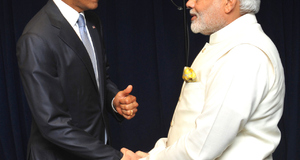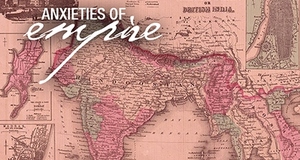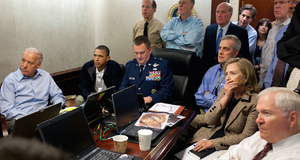Featured Article:Two Roadmaps for Kashmiri Democracy
By
2014, Vol. 6 No. 08 | pg. 4/4 | « Recommending BalanceThe preceding analyses should emphasize that both roadmaps are far from perfect. However, abandoning both schemes on the basis of their shortcomings would be inefficient, irresponsible, and, frankly, unfeeling. Even if a middle path between the two roadmap is unfeasible, a plan for peace and democracy that combines their best elements is imperative. Firstly, a nongovernmental agency or international organization known for impartiality should be tasked with creating and/or modifying a definitive roadmap if necessary but definitely overseeing the transformation of Kashmir. The parliamentary delegation, the JKLF, and even the UN were arguably bound to have vested interests to some degree. These entities, along with India, Pakistan, and the Kashmiri leadership, will have to come together to make democracy in Kashmir work, but that does not mean that they should be trusted to fairly set up the democratic mechanisms in question. In opposition to this, the Carter Center would probably be an excellent organizational candidate for supervising the democratic transition. Having dedicated more than a decade to Sudan’s civil conflict, the Center would be more than capable of placing all key players in Kashmir under international security during and after the transition.As far as the features of a hybrid roadmap are concerned, an independent state may not be the answer to all of Kashmir’s problems, but it is exponentially preferable to any continuation of Indian or Pakistani rule. Even if India and Pakistan enter into agreements with Kashmir with genuinely altruistic intentions, far too many of the Kashmiri people have suffered under external domination for far too long to consent to a continuation of the status quo on either side of the border. It goes without saying that avoiding a prolongation of the dispute should be a top priority for all involved. A conjoining of the two halves of Kashmir in independence could spell something of a fairytale ending to a torrid tale in optimal circumstances. However, the needs of Indian and Pakistani-controlled should be assessed separately before two peoples separated by time and culture are thrown together. The two halves may need to secure independence separately before they begin to see each other in any sort of brotherly light. Addressing the needs of both segments would be arduous and time-consuming, but it may well prove a better alternative than throwing everyone and the proverbial kitchen sink into a melting point and hoping for the best. On a different note, the JKLF may have called for a referendum after fifteen years of independence with a view towards emphasizing the empowerment of the Kashmiri people; while their empowerment will be the bedrock of any successful solution to the Kashmir question, a referendum organized by an external entity like the UN may not sit well with Kashmiris wary of intervention from the outside world. As an alternative to this, any independent state in the Kashmir region could be granted the ability to sign treaties, enter into trade agreements, or even join with its neighbors if its citizens desire such action. Even if various ethnic, political, and religious groups in Kashmir do not initially or ultimately come together within the boundaries of a single state, dialogue and cultural exchange between them should be encouraged as extensively as possible. Augmented cultural integration and intercultural integration over a period of time may render quarrels between national leaders irrelevant for the most part, maybe even to the extent that reunification will become the only sensible way forward for Kashmir. A serious collaborative drive to achieve these crucial ends would probably have to involve not only “artists, students, and intellectuals” (Gill and Kumar, 2012), but also entire educational institutions, business leaders and their corporations, administrators of all levels, nonprofit organizations and activists, and policy think tanks, to name but a few potential contributors. A Long but Imperative Walk to FreedomThis paper began by detailing the historical and political contexts of two roadmaps for Kashmiri peace and democracy put forward by the Jammu Kashmir Liberation Front and an Indian parliamentary delegation assembled in 2010. Thereafter several theoretical frameworks, including realism, liberalism, normative IR, constructivism, and South Asian IR were considered an applied to each roadmap before making recommendations based on this analysis. While just two roadmaps for Kashmir’s future were considered here, plenty more exist, and not all lead toward peace and democracy. As much as international relations scholars must critically analyze all of these approaches, they also have a moral obligation to discard solutions that stand to harm the Kashmiri people. To ignore decades of suffering and do otherwise would be to ignore one of the most pressing unresolved humanitarian causes of our time. For all the economic, political, and religious motivations intertwined in the Kashmir question, it is Kashmiri men, women, and children who have paid most, in blood and tears, for the ongoing conflict. ReferencesBarnett, M. (2011) Social Constructivism. In Baylis, J., & Smith, S. (Eds.) The Globalization of World Politics (pp. 149-165). Oxford: Oxford University Press. Dunne, T. (2011) Liberalism. In Baylis, J., & Smith, S. (Eds.) The Globalization of World Politics. Oxford: Oxford University Press. Dunne, T., & Schmidt, B. (2011). Realism. In Baylis, J., & Smith, S. (Eds.) The Globalization of World Politics. Oxford: Oxford University Press. Erskine, T. (2013) Normative IR Theory. In Dunne, T., Milja, K., and Smith, S. (Eds.) International Relations Theories. Oxford: Oxford Higher Education. Gill, N. and Kumar, H. (2012) Is This Kashmir’s Road Map for Peace? The New York Times. Retrieved April 26, 2013, from http://india.blogs.nytimes.com/2012/05/24/is-this-kashmirs-road-map-for-peace/?_php=true&_type=blogs&_r=0 Inayatullah, S. (2008) Distant Futures and Alternative Presents for South Asia. In Behera, N. and Chadha, N. (Eds.) International Relations in South Asia: Search for an Alternative Paradigm. New Delhi: Sage Publications. Jammu Kashmir Liberation Front. (n.d.) JKLF Roadmap for Solution of Kashmir Issue. Jammu Kashmir Liberation Front. Retrieved April 26, 2013, from http://jklfajkgbzone.org/index.php/2012-11-23-13-24-14/2012-12-02-19-08-34/jklf-roadmap Safvi, S. (2013) Protest in Kashmir against life sentences. Press TV. Retrieved April 26, 2013, from http://www.presstv.ir/detail/2013/04/20/299206/protest-in-kashmir-against-life-sentences/ Who are the Kashmir militants? (2012, August 1) BBC News. Retrieved April 26, 2013, from http://www.bbc.com/news/world-asia-18738906 Suggested Reading from Inquiries Journal
Inquiries Journal provides undergraduate and graduate students around the world a platform for the wide dissemination of academic work over a range of core disciplines. Representing the work of students from hundreds of institutions around the globe, Inquiries Journal's large database of academic articles is completely free. Learn more | Blog | Submit Latest in Political Science |


















